We can easily paginate a Recyclerview with the Firestore collection. But in my case, I have three dependent collections. They are
1. product (10000000 entries expected)
2. category (100000 entries expected)
3. region (50000 entries expected)
In Recyclerview I have to show details of product, category, and region like in the below image. As we know, there is no option for inner join queries like SQL. I have category id and region id stored in each product object. After fetching the products list I have to fill the category name and the region name based on the category and region id in each product object. After building that list of products, I have to pass this to Recyclerview adapter. How can I achieve these kinds of complex architecture with Firestore to meet normal SQL features? In my case, Firestore is confirmed. Also, there will be pagination.
I tried by fetching all categories and regions in different variables while initializing the page. While paginating, I have to find and put desired category name and region name based on their ids. But we need to keep both category and region list variables with a large number of data till the end of the activity which is not a good practice. I need to overcome this. FYI: I am using Kotlin
Please take a look at the below samples of the basic structure of each document object.
Product
{
"productId": 122,
"productName": "product name 1",
//other product details here
"categoryId": 758,
"regionId": 395
}
Category
{
"categoryId": 90474,
"categoryName": "category name 200",
//other category configuration details here
}
Region
{
"regionId": 2372,
"regionName": "tokyo",
//other region details here
}
Practical scenario
If I need to give a specific percentage of discount to specific categories, then we need to calculate it separately in each row of products.
If I need to show different shipping charges based on different regions, then also the same issue.
That means every time I added specific details to the category and region, then I have to update all products in the list with the updated region and category details.
